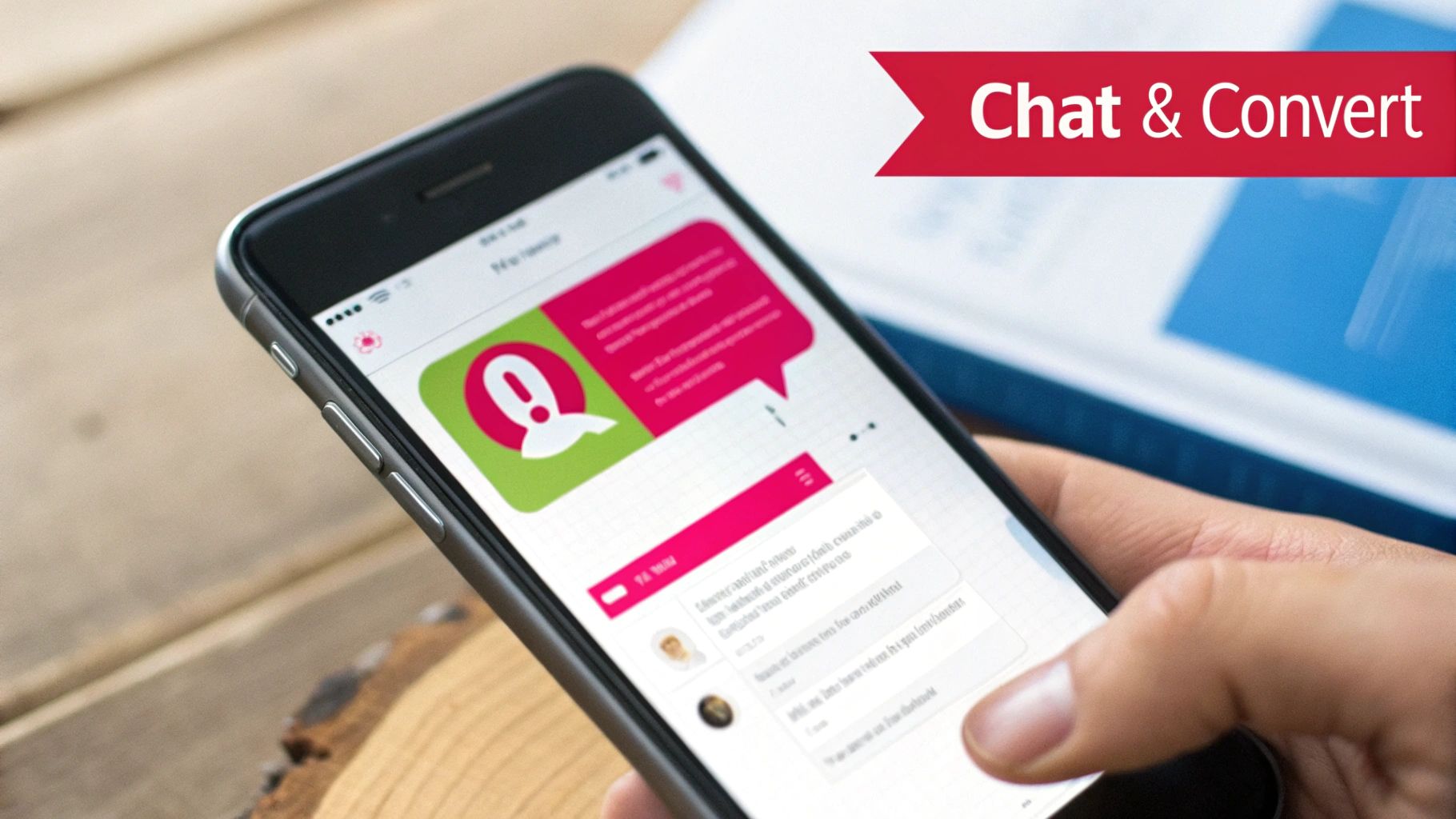Why Your Funnel is Leaking: The Power of Strategic Lead Nurturing
Generating leads is only half the battle. Without a robust strategy to guide them, potential customers often fall through the cracks, resulting in wasted marketing spend and missed revenue opportunities. Effective lead nurturing bridges this gap. It's the art and science of building relationships with prospects at every stage of their journey, providing them with the right information at the right time. This isn't about sending generic email blasts; it's about creating personalised, value-driven conversations that build trust and guide leads towards a purchase decision.
To ensure a healthy top-of-funnel and feed your nurturing efforts, understanding robust LinkedIn lead generation strategies is crucial. Once those leads are in your system, the real work begins. Your goal is to move beyond simple communication and cultivate genuine engagement that makes your brand the obvious choice when they are ready to buy.
In this article, we will deconstruct six powerful lead nurturing campaign examples from industry leaders like HubSpot and Drift. We'll go beyond the surface to analyse the specific tactics, strategic thinking, and replicable frameworks you can adapt for your own business. You will learn how to build high-converting nurture sequences designed to turn more prospects into loyal customers.
1. HubSpot's Educational Email Sequence
HubSpot has fundamentally shaped modern lead nurturing, moving the industry away from aggressive sales pitches towards a more educational, value-driven approach. Their strategy is a masterclass in inbound marketing, centred on automated email sequences that guide prospects through the buyer's journey. Instead of pushing a sale, HubSpot provides genuinely useful content, positioning themselves as a trusted authority in marketing, sales, and customer service.
This approach works by delivering a series of targeted emails based on a prospect's initial engagement. For example, if a user downloads an ebook on social media marketing, they are entered into a sequence that provides related tips, templates, and case studies. This method nurtures the lead by consistently offering value, building trust, and keeping the HubSpot brand top-of-mind.
Strategic Breakdown and Key Tactics
HubSpot's success with this lead nurturing campaign example isn't accidental; it's built on a sophisticated, data-driven framework. They meticulously segment their audience based on behaviour, interests, and their stage in the buyer's journey (awareness, consideration, decision). This allows for highly personalised content delivery that feels less like a marketing blast and more like a helpful conversation.
Key tactics they employ include:
- Progressive Profiling: Instead of asking for 10 pieces of information upfront, forms only ask for a few key details. On subsequent interactions, new form fields appear, gradually building a comprehensive contact profile without overwhelming the user.
- Content Upgrades: Blog posts and articles often include offers for supplementary content, like a checklist or template. This serves as a natural transition, moving a prospect from consuming free content to engaging more deeply with the brand.
- Lead Scoring: HubSpot assigns points to leads based on their actions (e.g., opening an email, visiting the pricing page, downloading a guide). Once a lead reaches a certain score, they are identified as "sales-ready" and passed to the sales team for a more direct follow-up.
This process flow infographic illustrates how HubSpot uses behaviour to trigger and personalise its educational sequences.

The visualisation highlights how each action a prospect takes initiates a cycle of personalised education and data collection, which in turn fuels more precise nurturing.
Actionable Takeaways for Your Business
You can replicate this strategy by focusing on education over promotion. Start by mapping your own buyer's journey and identifying the key questions your prospects have at each stage. Develop high-value content like guides, webinars, and templates that answer these questions. Organise these assets into automated email sequences using marketing automation software. This approach not only generates more qualified leads but also builds lasting brand loyalty. You can find more inspiration by exploring other top-tier email marketing examples on grassrootscreativeagency.com.
2. Salesforce's Multi-Touch Attribution Campaign
Salesforce has pioneered a highly sophisticated approach to lead nurturing by integrating multi-touch attribution directly into its campaigns. Instead of looking at a single interaction, Salesforce's strategy evaluates the entire customer journey, tracking prospects across numerous channels like email, social media, webinars, and even direct mail. This holistic view, powered by AI, allows them to understand which touchpoints are most influential in moving a lead towards conversion.
This method works by assigning value to each interaction a prospect has with the brand. For instance, a lead might first discover Salesforce through a LinkedIn ad, later attend a Dreamforce conference session online, and then download an industry-specific whitepaper. A multi-touch campaign recognises the importance of all these steps, delivering personalised content that reflects the prospect's comprehensive engagement history. This makes the nurturing process more relevant, timely, and effective.
Strategic Breakdown and Key Tactics
Salesforce's success with this lead nurturing campaign example stems from its ability to connect data from disparate sources into a single, unified customer profile. Their framework is built on understanding and adapting to individual prospect behaviours, ensuring messaging is consistent yet customised for the specific channel and journey stage. This data-centric model allows for precise targeting, especially in complex B2B sales cycles.
Key tactics they employ include:
- AI-Powered Personalisation: Salesforce uses its Einstein AI to analyse engagement data and predict the optimal content, channel, and timing for the next interaction. This moves beyond simple automation to predictive, individualised nurturing.
- Industry-Specific Campaigns: Rather than a one-size-fits-all approach, Salesforce creates dedicated nurturing sequences for key verticals like healthcare, finance, and retail. These campaigns feature case studies, regulatory insights, and solution guides tailored to the unique challenges of each industry.
- Account-Based Marketing (ABM) Integration: For high-value enterprise prospects, Salesforce aligns its marketing and sales efforts to target key accounts. The multi-touch attribution model is crucial here, as it helps track engagement from multiple stakeholders within a target company, providing a complete picture of an account's interest level.
This integrated strategy ensures that every marketing action is measured and optimised, creating a powerful feedback loop that continuously refines their approach.
Actionable Takeaways for Your Business
You can adopt a similar strategy by focusing on data integration and customer journey mapping. Start by identifying all the touchpoints where prospects interact with your brand. Use tracking tools like UTM parameters and marketing automation platforms to connect this data. Begin with a basic attribution model, such as linear or time-decay, to understand which channels contribute most to your conversions. As you gather more data, you can build more complex, customised models. This approach will not only improve your ROI but also provide deep insights into customer behaviour. For businesses aiming to build such robust systems, exploring advanced lead generation in Dubai can offer valuable frameworks and expertise.
3. Mailchimp's Behavioural Trigger Campaign
Mailchimp has pioneered making sophisticated marketing automation accessible, particularly through its powerful use of behavioural triggers. This strategy moves beyond static email lists to deliver hyper-relevant messages based on specific user actions or inactions. By monitoring website behaviour, email engagement, and product usage, Mailchimp’s system sends timely content that guides prospects through the conversion funnel precisely when they are most receptive.

The core principle of this approach is action-and-reaction. A new subscriber receives a welcome series; a user who abandons their cart gets a reminder; an inactive user is sent a re-engagement campaign. This dynamic interaction makes the communication feel personal and responsive, transforming a generic marketing broadcast into a one-on-one conversation that nurtures leads effectively.
Strategic Breakdown and Key Tactics
Mailchimp’s success with this lead nurturing campaign example stems from its ability to automate personalisation at scale. The platform enables businesses to define specific triggers that correspond to critical moments in the customer lifecycle. This ensures that every automated email serves a distinct purpose, from onboarding and education to retention and upselling.
Key tactics they employ include:
- Segmented Welcome Series: Instead of one welcome email, new subscribers are often funnelled into different sequences based on how they signed up. A user who subscribed via a blog post about SEO might receive different initial content than someone who signed up from the main pricing page.
- Onboarding Based on Usage: For users on a free trial, Mailchimp triggers emails based on feature adoption. If a user has created a list but not sent a campaign, an email might be triggered offering a guide or template to help them take that next step.
- Proactive Re-engagement: The platform can automatically identify subscribers who haven't opened an email in, for example, 90 days. This triggers a specialised "win-back" campaign offering a special incentive or asking for feedback, actively preventing list attrition.
This approach ensures that messages are not only timely but also contextually aware, significantly increasing their impact and relevance to the recipient.
Actionable Takeaways for Your Business
You can implement a similar behavioural trigger strategy by first mapping out your own customer journey. Identify the key actions (or inactions) that signify a shift in a lead's engagement or intent. Use a marketing automation platform to set up "if-then" rules for these moments. For instance, if a prospect visits your pricing page three times in a week, then send them an email with a case study or an invitation for a demo. Start simple with a welcome series or an abandoned cart reminder, and gradually build more sophisticated trigger-based workflows as you collect more data.
4. Adobe's Content Experience Platform Campaign
Adobe exemplifies a "show, don't tell" lead nurturing strategy by using its own powerful marketing technology stack to deliver hyper-personalised content experiences. This approach moves beyond simple email sequences, creating a cohesive journey across multiple channels. By leveraging visitor behaviour, engagement history, and stated preferences, Adobe demonstrates the immense power of its products while skilfully nurturing leads.
This campaign works by treating every interaction as a data point to refine the user's experience. Whether a prospect is attending an Adobe Summit event, starting a Creative Cloud trial, or exploring enterprise solutions, the content they receive is dynamically tailored. For instance, a graphic designer in a free trial might receive tips on using specific Photoshop features, while a marketing director who downloaded a whitepaper receives case studies relevant to their industry. This creates a deeply relevant and compelling journey that showcases product value and builds a strong case for purchase.
Strategic Breakdown and Key Tactics
Adobe's strategy is built on the foundation of its own integrated ecosystem, like Adobe Experience Cloud, which allows them to track, analyse, and act on user data in real time across web, email, and social touchpoints. This unified customer view is the engine behind their sophisticated personalisation, making their lead nurturing campaign examples particularly insightful for B2B and B2C companies alike.
Key tactics they employ include:
- Omnichannel Personalisation: Adobe doesn't limit nurturing to email. They connect user data across their website, apps, and advertising channels to ensure a consistent and personalised experience everywhere a lead interacts with their brand.
- Behavioural and Contextual Targeting: Nurturing is triggered by specific actions, such as content downloads or trial sign-ups, but it's also refined by context. This includes the lead's industry, job role, and previous engagement patterns, ensuring the messaging is always relevant.
- Post-Event Nurturing: Following major events like the Adobe Summit, attendees are segmented based on the sessions they attended. This allows Adobe to send highly specific follow-up content, from session recordings to related case studies, keeping the momentum going and guiding leads toward deeper engagement.
Actionable Takeaways for Your Business
You can model Adobe's approach by focusing on creating a unified customer experience, even if you don't have their extensive tech stack. Start by integrating your CRM, email marketing platform, and website analytics to get a clearer picture of your customer's journey. Use this data to deliver personalised content that speaks directly to their needs and demonstrated interests. Focus on the quality of your content and how it showcases your product's or service's value in a practical way. Remember to A/B test your messaging and creative assets to continuously optimise your nurturing sequences for better engagement and conversion.
5. LinkedIn's Social Proof Nurturing Campaign
LinkedIn has perfected the art of leveraging its greatest asset, its professional network, to nurture leads through powerful social proof. Instead of telling prospects how valuable its premium services are, LinkedIn shows them. Their lead nurturing campaigns are built on a foundation of user-generated success stories, data-backed case studies, and peer-to-peer endorsements, creating an environment of trust and credibility. This strategy effectively creates a sense of FOMO (fear of missing out) by demonstrating the tangible career and business benefits others are achieving.
This approach works by integrating success stories directly into the user experience and targeted marketing communications. Whether it's showcasing how a sales team boosted its pipeline with Sales Navigator or how a marketer achieved incredible ROI with LinkedIn Ads, the message is always reinforced by real-world examples. This method nurtures leads by validating the platform's claims with undeniable evidence from peers and competitors, making the decision to upgrade or invest feel less like a purchase and more like a strategic necessity.
Strategic Breakdown and Key Tactics
LinkedIn’s success with this lead nurturing campaign example stems from its ability to systematically collect and deploy social proof across different user segments. They understand that a recruiter is motivated by different success metrics than a sales professional, and they tailor their social proof content accordingly. This creates a highly relevant and persuasive narrative that speaks directly to a prospect’s specific goals and pain points.
Key tactics they employ include:
- Segmented Success Stories: LinkedIn creates dedicated campaigns for its various products, like Sales Navigator for sales teams or LinkedIn Learning for professional development. They feature case studies and testimonials from professionals in similar roles and industries, making the success feel attainable and relevant to the prospect.
- Data-Driven Proof Points: Their campaigns are rich with specific metrics and data. Instead of just saying a company "succeeded," they will state that a company "saw a 35% increase in qualified leads" or "reduced time-to-hire by 50%." This quantitative evidence adds significant weight to their claims.
- Peer-to-Peer Engagement: LinkedIn encourages and highlights user achievements, such as course completions on LinkedIn Learning or work anniversaries. This public recognition not only engages the individual but also serves as subtle social proof to their entire network, showcasing the platform's role in professional growth.
This cycle of showcasing user success creates a powerful, self-perpetuating engine for lead nurturing.
Actionable Takeaways for Your Business
You can adopt this strategy by making customer success a centrepiece of your marketing efforts. Start by actively collecting testimonials, case studies, and user-generated content. Don't just ask for a generic review; prompt customers to share specific results and metrics they've achieved with your product or service. Integrate this social proof into your email nurture sequences, landing pages, and social media content. This method builds immense trust and helps prospects visualise their own success, making it one of the most effective lead nurturing campaign examples to replicate. For further ideas on leveraging social platforms, you can find inspiration in these other powerful social media campaign examples on grassrootscreativeagency.com.
6. Drift's Conversational Marketing Campaign
Drift has fundamentally revolutionised the lead nurturing landscape by shifting the focus from passive email sequences to active, real-time conversations. Their approach centres on conversational marketing, a strategy that engages prospects the moment they show interest on a website. Instead of making potential customers fill out a form and wait for a response, Drift uses intelligent chatbots and live chat to provide instant value, answer questions, and guide them through the sales funnel via personalised dialogue.
This strategy works by treating website visitors like potential customers in a physical store, offering immediate assistance and tailored guidance. When a visitor lands on a key page, a chatbot can proactively engage them, qualify their interest, and even book a demo with a sales rep in real time. This immediacy collapses the sales cycle and creates a highly engaging customer experience, making it one of the most effective modern lead nurturing campaign examples.

Strategic Breakdown and Key Tactics
Drift’s success is built on a principle of immediacy and personalisation at scale. The core idea is to replace anonymous, one-way communication channels like forms with two-way, human-centric conversations. This is not just about having a chat widget; it is about strategically designing conversation flows that align with the buyer’s journey and business goals. They have effectively turned the traditional lead magnet funnel on its head.
Key tactics they employ include:
- Proactive Chatbot Engagement: Drift’s bots don't just wait for a visitor to start a chat. They use “playbooks” to initiate conversations based on visitor behaviour, such as time on page, referring source, or the specific content being viewed. For example, a visitor on the pricing page might get a message like, "See our pricing? I can help you find the right plan. Are you a small business or an enterprise?"
- Real-Time Lead Qualification and Routing: Chatbots are used to ask qualifying questions upfront, gathering information that would typically be on a lead form. Based on the answers, the bot can instantly route high-intent leads to the right sales representative for a live conversation, while nurturing lower-intent leads with helpful resources.
- Integrating Chat Data with CRM: Every conversation provides valuable data. Drift integrates seamlessly with CRM systems like Salesforce, automatically creating or updating contact records with conversation transcripts and insights. This ensures the sales team has full context for future interactions.
This video from Drift explains the core philosophy behind their conversational framework and how it accelerates revenue.
Actionable Takeaways for Your Business
You can implement a conversational marketing strategy by starting small. Identify the highest-traffic pages on your website where visitors are most likely to have questions, such as your pricing or product pages. Implement a chatbot with a simple, helpful opening message. Your goal is to be helpful first and sell second. Create conversation flows that answer common questions and guide users toward a specific action, like scheduling a demo or downloading a resource. For a deeper dive into the broader trends and future of conversational intelligence that power such campaigns, explore the future of conversational intelligence and how it is shaping customer interactions. By meeting customers where they are and when they are ready, you can significantly shorten your sales cycle and improve the overall customer experience.
Lead Nurturing Campaigns: 6-Example Comparison
| Campaign Title | Implementation Complexity 🔄 | Resource Requirements 💡 | Expected Outcomes 📊 | Ideal Use Cases 💡 | Key Advantages ⭐ |
|---|---|---|---|---|---|
| HubSpot's Educational Email Sequence | Medium – requires content creation and automation setup | High – content creation, CRM integration | Trust-building, thought leadership, steady lead nurturing | B2B software/marketing tech, Longer nurture cycles | Builds trust, scalable automation, high engagement |
| Salesforce's Multi-Touch Attribution Campaign | High – complex AI and multi-channel orchestration | Very High – data, AI tech, trained teams | Improved conversion, shorter sales cycles, better ROI | Enterprise B2B software, long enterprise sales cycles | Highly personalized, AI-driven, comprehensive tracking |
| Mailchimp's Behavioral Trigger Campaign | Medium – triggers setup and monitoring | Medium – tracking infrastructure needed | Timely, relevant messaging, improved conversion | SMB email marketing, short nurture cycles (30-90 days) | Relevant timing, scalable, automated efficiency |
| Adobe's Content Experience Platform Campaign | Very High – advanced personalization and tech stack | Very High – technical resources and tech costs | Personalized content experience, strong product demos | Creative/marketing tech, variable campaign length | Dynamic personalization, cross-channel, strong analytics |
| LinkedIn's Social Proof Nurturing Campaign | Medium – content curation and community management | Medium – user-generated content and management | Builds credibility, peer-driven conversions | Professional services, B2B networking, relationship building | High credibility, strong peer influence, trust-building |
| Drift's Conversational Marketing Campaign | Medium to High – chatbot development and live monitoring | Medium to High – chat ops and automation tools | Immediate engagement, shorter sales cycles, lead qualification | B2B SaaS, sales tech, real-time engagement | Real-time interaction, higher conversion rates, improved CX |
From Examples to Execution: Building Your Own Nurture Engine
We have journeyed through some of the most effective lead nurturing campaign examples from industry giants like HubSpot, Salesforce, and LinkedIn. From educational email sequences to sophisticated conversational marketing, these case studies demonstrate that successful lead nurturing is far more than just sending a series of automated emails. It's a strategic blend of psychology, technology, and value-driven content, meticulously organised to guide a potential customer from initial interest to loyal advocate.
The most potent takeaway from these examples is the power of a cohesive, multi-channel strategy. A single tactic rarely wins the race. The true magic happens when educational content (like HubSpot's) is combined with the social proof of a LinkedIn campaign, or when behavioural triggers (like Mailchimp's) are amplified by the immediacy of conversational marketing (like Drift's). This integrated approach ensures you meet your leads where they are, with the right message at the perfect moment.
Your Blueprint for Building a Nurture Engine
So, how do you move from inspiration to implementation? The path forward involves a structured approach, not guesswork. Here are the core principles to build upon:
- Map the Entire Customer Journey: Before writing a single email, visualise your ideal customer's path. What are their pain points at the awareness stage? What questions do they ask during consideration? What information do they need to make a final decision? Document these stages and the key touchpoints within them.
- Segment with Precision: As the examples from Salesforce and Adobe highlight, generic messaging falls flat. Segment your audience based on their behaviour, demographics, firmographics, and engagement level. A lead who has downloaded a pricing guide needs a different message than someone who only read a single blog post.
- Prioritise with Intelligence: A crucial, yet often overlooked, element is knowing which leads to focus on. To truly optimise your team's efforts and ensure you are nurturing the most promising prospects, a robust qualification system is essential. This is where mastering B2B lead scoring becomes a game-changer, allowing you to assign value to leads based on their actions and profile, ensuring your sales team engages at the optimal time.
The Ultimate Goal: Building Relationships at Scale
Ultimately, the goal of any lead nurturing campaign is to build authentic, lasting relationships. It's about demonstrating that you understand your prospect's challenges and are genuinely invested in their success. By providing consistent value, answering their questions proactively, and personalising their experience, you transform a cold lead into a warm prospect and, eventually, a loyal customer. This foundational work not only increases conversion rates but also builds the brand equity that drives long-term, sustainable growth for businesses here in the UAE and beyond.
At Grassroots Creative Agency, we specialise in crafting these bespoke, data-driven nurturing strategies that turn leads into revenue. We help businesses in Dubai move beyond generic email blasts to build powerful, automated conversion engines. Ready to stop losing leads and start building lasting customer relationships? Contact Grassroots Creative Agency to build your perfect nurture campaign today.








